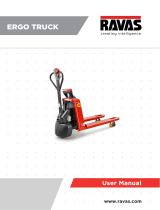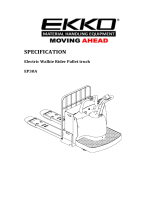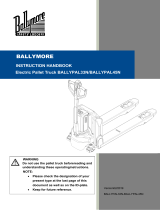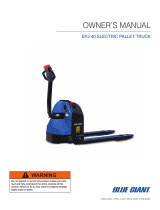I 3
1009.GB
12 Optional equipment ............................................................................. E 58
12.1 Headlights .......................................................................................... E 58
12.2 Beacon / strobe .................................................................................. E 58
12.3 Limit switch system / electrical lift limit switch ..................................... E 59
12.4 Seat heating ....................................................................................... E 60
12.5 12 V DC / 24 V DC transformer .......................................................... E 60
12.6 180°/360° steering angle display ........................................................ E 61
12.7 Sideshift centre position ..................................................................... E 61
12.8 Forks horizontal button ....................................................................... E 62
12.9 Weigher .............................................................................................. E 62
12.10 Clamp button ...................................................................................... E 63
12.11 Weatherproof cab ............................................................................... E 64
12.12 Parabolic mirror ................................................................................... E 65
12.13 Removable load backrest .................................................................... E 66
12.14 Rack Height Select .............................................................................. E 67
12.15 ISM access module ............................................................................. E 68
12.16 Assembly and hydraulic ports of additional attachments .................... E 69
F Industrial Truck Maintenance
1 Operational Safety and Environmental Protection .............................. F 1
2 Maintenance safety regulations .......................................................... F 2
3 Servicing and Inspection ..................................................................... F 6
4 ETM/V 214-325 Maintenance Checklist .............................................. F 7
5 ETM/V 214-325 Maintenance Schedule ............................................. F 9
5.1 Lubricants and Lubrication Schedule .................................................. F 10
5.2 Consumables ..................................................................................... F 11
5.3 Reservoir capacity ............................................................................... F 12
6 Maintenance Instructions .................................................................... F 13
6.1 Preparing the truck for maintenance and repairs ................................ F 13
6.2 Remove seat panel ............................................................................. F 14
6.3 Check the hydraulic oil level ................................................................ F 14
6.4 Opening the fuse cover ....................................................................... F 15
6.5 Opening the instrument panel cover ................................................... F 15
6.6 Checking electrical fuses .................................................................... F 16
6.7 Checking the wheel attachments. ....................................................... F 17
6.8 Recommissioning ................................................................................ F 17
7 Decommissioning the industrial truck .................................................. F 17
7.1 Prior to decommissioning: ................................................................... F 17
7.2 During decommissioning: .................................................................... F 18
7.3 Returning the truck to operation after decommissioning ..................... F 18
8 Safety checks to be performed at regular intervals and
following any unusual incidents ........................................................... F 19
9 Final de-commissioning, disposal ....................................................... F 19
10 Human vibration measurement ........................................................... F 19
I 3
1009.GB
12 Optional equipment ............................................................................. E 58
12.1 Headlights .......................................................................................... E 58
12.2 Beacon / strobe .................................................................................. E 58
12.3 Limit switch system / electrical lift limit switch ..................................... E 59
12.4 Seat heating ....................................................................................... E 60
12.5 12 V DC / 24 V DC transformer .......................................................... E 60
12.6 180°/360° steering angle display ........................................................ E 61
12.7 Sideshift centre position ..................................................................... E 61
12.8 Forks horizontal button ....................................................................... E 62
12.9 Weigher .............................................................................................. E 62
12.10 Clamp button ...................................................................................... E 63
12.11 Weatherproof cab ............................................................................... E 64
12.12 Parabolic mirror ................................................................................... E 65
12.13 Removable load backrest .................................................................... E 66
12.14 Rack Height Select .............................................................................. E 67
12.15 ISM access module ............................................................................. E 68
12.16 Assembly and hydraulic ports of additional attachments .................... E 69
F Industrial Truck Maintenance
1 Operational Safety and Environmental Protection .............................. F 1
2 Maintenance safety regulations .......................................................... F 2
3 Servicing and Inspection ..................................................................... F 6
4 ETM/V 214-325 Maintenance Checklist .............................................. F 7
5 ETM/V 214-325 Maintenance Schedule ............................................. F 9
5.1 Lubricants and Lubrication Schedule .................................................. F 10
5.2 Consumables ..................................................................................... F 11
5.3 Reservoir capacity ............................................................................... F 12
6 Maintenance Instructions .................................................................... F 13
6.1 Preparing the truck for maintenance and repairs ................................ F 13
6.2 Remove seat panel ............................................................................. F 14
6.3 Check the hydraulic oil level ................................................................ F 14
6.4 Opening the fuse cover ....................................................................... F 15
6.5 Opening the instrument panel cover ................................................... F 15
6.6 Checking electrical fuses .................................................................... F 16
6.7 Checking the wheel attachments. ....................................................... F 17
6.8 Recommissioning ................................................................................ F 17
7 Decommissioning the industrial truck .................................................. F 17
7.1 Prior to decommissioning: ................................................................... F 17
7.2 During decommissioning: .................................................................... F 18
7.3 Returning the truck to operation after decommissioning ..................... F 18
8 Safety checks to be performed at regular intervals and
following any unusual incidents ........................................................... F 19
9 Final de-commissioning, disposal ....................................................... F 19
10 Human vibration measurement ........................................................... F 19

























